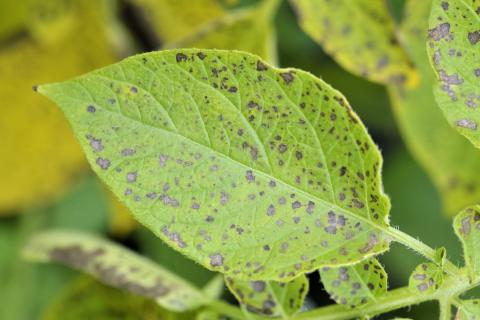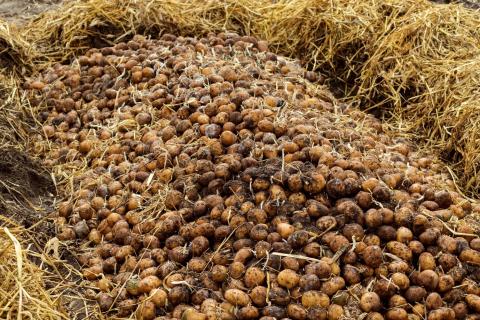17 June 2019
Dr Peter Wootton – Beard RNutr: IBERS, Aberystwyth University.
- New strains of potato blight are inevitable, requiring frequent reviews of control measures.
- Adherence to best practice for blight control is essential to prevent the spread of aggressive new strains.
- The ability to reduce susceptibility to blight in near-future varieties is a realistic possibility thanks to new genetic research tools.
Potato producers may already be uncomfortably familiar with the colours and numbers in the title of this article. That’s because they are the designated names for aggressive new strains of the fungus-type (actually an oomycete) organism Phytophthora infestans (Mont.), which have been found in the UK since 2005. P. infestans causes (late) potato blight, and failures in its control are responsible for the complete crop losses and resulting suffering that are so clearly etched upon the collective historical memory. This article is designed to provide an update on the status of the disease and the varietal resistance to new strains, as well as a review of effective control measures, and a summary of the latest scientific research to combat the problem. It is noted that early blight, caused by Alternaria solani or Alternaria alternata is also of growing concern in the UK and Europe, although its spread is less dramatic, it affects foliage more than tubers, and (at present) it is less commercially impactful. This article focuses on late blight, but the risk factors and control measures are similar. More information on early blight is available from AHDB.
Characterised by the all too familiar brown patches and lesions on foliage, late blight is most commonly spread from infected foliage via windblown spores, which can travel vast distances under the right meteorological conditions. An ‘early arrival’ of late blight is most devastating because it can kill the plant before any tubers have formed, preventing any harvestable produce from being recovered. Particularly dramatic infections occur under moist conditions because spores landing on a wet leaf can ‘swim’ all over the foliage resulting in very rapid spread. These spores are the result of asexual reproduction which creates clones of the original organism. However, P. infestans is also able to reproduce sexually when A1 and A2 forms recombine and exchange DNA. This results in the creation of oocytes of new hybrid strains which can survive in the soil for several years. The ability to sexually reproduce means that new strains of P. infestans are inevitable where both A1 and A2 forms are present.
The characteristic brown spots/legions caused by Phytophthora infestans (Mont.).
Update on blight strains
Prior to 2005, most strains of late blight were A1 types. These would infect a crop and then asexually reproduced clonal spores would be released that would spread and infect other crops. This meant that even at multiple sites of infection, the same organism (or at least a clone of it) were present. There was some resistance to certain chemicals in the population, but it could be managed with a good anti-resistance strategy. This routine appearance of a familiar enemy lent itself to routine treatment, with a limited range of fungicides, known to be effective against the strain in question. Since 2005 however, there have been major changes in the UK P. infestans population, primarily due to the arrival of A2 mating forms, which have made sexual reproduction between the two forms possible. In the last 10 years, two major new strains of the pathogen have appeared in the UK and begun to dominate infections. 13_A2 (Blue 13) was the first to be identified en masse and likely travelled to the UK via the European continent where it had already become established. A little later 6_A1 (Pink 6) was found, and its prevalence has steadily increased. In very recent years, additional new strains including 37_A2 (Dark Green 37) have been found. All of these new strains are particularly aggressive, largely because they have acquired, through genetic mutation, resistance to routinely used fungicides. Dark Green 37 is of particular concern because it appears to be equally aggressive on both foliage and tubers, whilst previous strains were less aggressive toward tubers. The appearance of these new strains, their acquisition of resistance to fungicides, and the inevitability of further strains through sexual reproduction, have meant that producers need more robust control strategies, and may need to consider growing new varieties, or adopting new practices.
Varietal resistance and breeding
The appearance of new strains of P. infestans (particularly the dominant Blue 13) has resulted in a revision of the blight resistance of many varieties which were previously rated 5 or higher. This has precipitated a dilemma for growers; grow resistant varieties, or continue to grow varieties that customers demand and are familiar with, which are now more susceptible? In particular, early potato varieties are considered much more susceptible to blight, and although they have commonly been harvested before the high blight pressure season, could act as a significant vector for the disease in the case of early arrival or less rigorous control.
In breeding terms, the key is the number of so-called R (resistance genes) that a variety possesses. Prior to 2005, breeding efforts had shifted to developing only partial resistance, which, in combination with the appropriate control measures was deemed sufficient. However, in this new age, with an unpredictable foe, there is a renewed effort to incorporate more R genes into new varieties whilst balancing the desirable traits that confer culinary superiority. The family to which our common potatoes belong (Solanum) contains 150 tuber-bearing species, and many are resistant to blight (containing as many as 11 R genes), which provides the gene pool from which resistance genes can be found for new modern varieties. Current breeding approaches are attempting to discover which R genes confer a practical advantage in commercial production.
Scientists have discovered, that clusters of R genes are required for effective and sustainable resistance and that single genes applied to varieties are often of less practical value. This cluster approach mimics how R genes operate in nature, and represents a future strategy for potato breeding. It is hoped that if they can be introduced into varieties without compromising culinary value, this approach could lead to a reduction in fungicide use, and greater yield survival following infection. There are new varieties available commercially now that have at least single R genes, such as Carolus, Alouette and Twister by Agrico or Sarpo Mira by Danespo, which is the highest rated variety (in terms of resistance), and one of the only varieties to increase its rating on the revised AHDB list.
Review and update of effective control measures
Effective control measures have changed little in recent decades, but the information upon which decisions about control are made, have. The availability of sensors, imaging and data analyses in particular, have made it possible to better understand the risk factors for high blight pressure conditions, resulting in more effective advice and better early warning systems. Control measures can be divided into three main categories; management practices, risk warning mechanisms and active treatments.
Management practices
The following list is not exhaustive, but covers the most crucial basic processes, that can help to reduce the risk of the disease spreading.
- Seed selections which carry the ‘Safe Haven’ logo.
- Selecting cultivars which confer natural resistance.
- Destroying overwintering sites such as outgrade piles.
- Covering outgrade piles with heavy gauge black polythene as a minimum.
- Developing good biosecurity measures to prevent accidental contamination from people such as groundsmen, contractors and volunteers.
- Not saving seed, and ensuring all of the harvest is removed from the soil.
- Considering the longest possible rotation gaps, as any infestation in the soil will eventually die without a host.
Some success has also been seen anecdotally with practices such as alternating rows of different varieties with different levels of resistance, mulching to protect tubers from infection, minimising leaf water (through more targeted base irrigation) and total burning-off of above-ground material once infection has been detected, in order to protect the tubers.
Outgrade piles are a major source of infection, and should be destroyed.
Risk warning mechanisms
The most favourable meteorological conditions were, until recently, known as a ‘Smith period’. The criteria defining these periods has been refined and they are now known as ‘The Hutton Criteria’, after the James Hutton Institute where they were developed (Table 1). They describe periods of humid, warm weather, which are likely to become more frequent in light of the effects of climate change.
Table 1: ‘Old’ Smith period vs. ‘New’ Hutton Criteria
|
Old Smith period |
|
New! Hutton criteria |
|
|
|
|
|
Two consecutive days: |
Two consecutive days: |
|
|
|
|
|
|
Although imperfect, adoption of the Hutton Criteria has led to some improvement in detection and reporting, and the research has been converted into a user friendly toolkit by AHDB called ‘Fight against Blight’. New initiatives have also been developed to help aid the reporting of blight cases and enhance early warning systems, including the recruitment of ‘blight scouts’ by AHDB’s sister service Blightwatch.
Active treatments
Fungicides have been used effectively to prevent infection for a number of years, but the acquisition of resistance by new, aggressive strains means that the type of chemicals which are used may need to change. One of the most commonly applied fungicides (fluazinam) may now also be approaching the end of its usefulness because of the resistance of new strains such as Dark Green 37. In a further example, Blue 13 has acquired resistance to phenalymides. The most repeated advice for active treatment is to use a fungicide product which contains a mix of agents with different chemistry from one another, and to adhere to the manufacturers recommended spray intervals (e.g. Table 2). Some new classes of fungicides such as dithiocarbamates are becoming more popular as a result. In addition producers are advised to:
- Start spraying programmes as soon as a warning is received, and in relation to the specific context of the farm (exposure, rainfall, planting date etc.).
- Maximise coverage by selecting the correct nozzles and spraying equipment.
- Use effective spray intervals, 7 days is recommended.
- Not to attempt to extend spray intervals.
- Consider separating blight fungicides and desiccation, applying blight fungicide 2-3 days after the desiccant to allow lower leaves and stems to be treated.
Table 2 – Example fungicide recommendation made by Shailes, (2018)
|
Early Season |
Mid-Season |
Late Season |
|
cymoxanil |
oxathiapiprolin |
fluopicolide |
|
mancozeb |
|
cyazofamid |
|
benthiavalicarb |
|
zoxamide |
|
fluopicolide+ propamocarb |
|
|
|
|
|
|
Latest scientific advances
‘Omic’ technologies are at the forefront of a scientific revolution that is making it possible to understand the factors which lead to disease in much greater detail. Using these techniques, scientist are now able to understand what it is about potatoes that makes them susceptible to attack by blight. The hope is, that once this process is understood it will be possible to remove susceptibility genetically, or more precisely target mechanisms of infection using new, more effective chemical and non-chemical control measures. The latest microbiological research is being pioneered by scientists at the James Hutton Institute, who are focusing on the developmental stages of infection, and in particular a site in the cells where the host (potato) and the pathogen (blight) interact the most, called the haustorium. At this site there is an exchange of molecules which results in ‘instructions’ being passed to the plant which tell it how to react, allowing the pathogen to invade. It is hoped that studies of this exchange could lead to mechanisms which ‘block’ or ‘scramble’ these ‘instructions’, enhancing the resistance of the plant to invasion. There are also a range of other novel approaches in development including the use of natural bio-pesticides such as saponins, which can be isolated from common indigenous plants such as ivy, representing a sustainable alternative option to current fungicides for the future.
Advances in scientific research, as well as technological advances, are improving blight management
Summary
Both early, and late potato blight are of increasing concern to producers, in light of climate change and shifts in the UK population of the respective pathogens. In the case of late blight, the arrival since 2005 of A2 mating forms of P. infestans has made it inevitable that new, aggressive strains of the disease will emerge. It is therefore increasingly important that management practices are revisited, and if necessary, revised, to account for the renewed threat of infection. Efforts to control the impacts of blight are supported by the development of new varieties carrying resistance (R) genes, which still maintain favourable culinary attributes, and by cutting edge research into the microbiology of plant-pathogen interactions, which may in time, give producers new weapons to use in the fight against blight.




